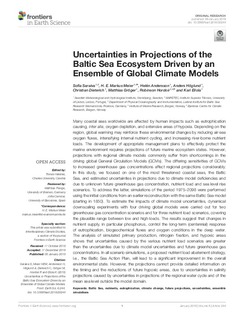| dc.description.abstract | Many coastal seas worldwide are affected by human impacts such as eutrophication causing, inter alia, oxygen depletion, and extensive areas of hypoxia. Depending on the region, global warming may reinforce these environmental changes by reducing air-sea oxygen fluxes, intensifying internal nutrient cycling, and increasing river-borne nutrient loads. The development of appropriate management plans to effectively protect the marine environment requires projections of future marine ecosystem states. However, projections with regional climate models commonly suffer from shortcomings in the driving global General Circulation Models (GCMs). The differing sensitivities of GCMs to increased greenhouse gas concentrations affect regional projections considerably. In this study, we focused on one of the most threatened coastal seas, the Baltic Sea, and estimated uncertainties in projections due to climate model deficiencies and due to unknown future greenhouse gas concentration, nutrient load and sea level rise scenarios. To address the latter, simulations of the period 1975–2098 were performed using the initial conditions from an earlier reconstruction with the same Baltic Sea model (starting in 1850). To estimate the impacts of climate model uncertainties, dynamical downscaling experiments with four driving global models were carried out for two greenhouse gas concentration scenarios and for three nutrient load scenarios, covering the plausible range between low and high loads. The results suggest that changes in nutrient supply, in particular phosphorus, control the long-term (centennial) response of eutrophication, biogeochemical fluxes and oxygen conditions in the deep water. The analysis of simulated primary production, nitrogen fixation, and hypoxic areas shows that uncertainties caused by the various nutrient load scenarios are greater than the uncertainties due to climate model uncertainties and future greenhouse gas concentrations. In all scenario simulations, a proposed nutrient load abatement strategy, i.e., the Baltic Sea Action Plan, will lead to a significant improvement in the overall environmental state. However, the projections cannot provide detailed information on the timing and the reductions of future hypoxic areas, due to uncertainties in salinity projections caused by uncertainties in projections of the regional water cycle and of the mean sea level outside the model domain. | nb_NO |
